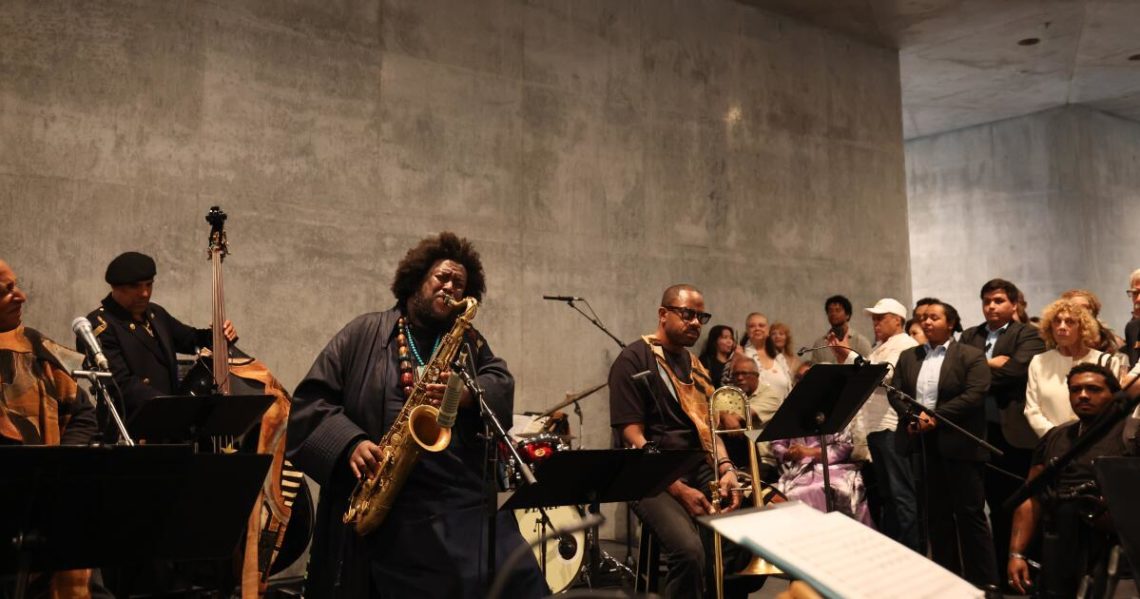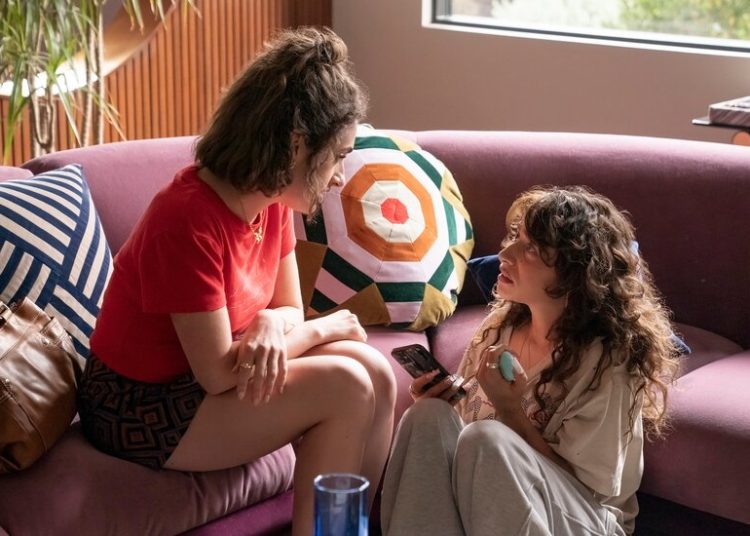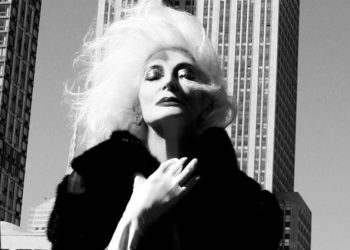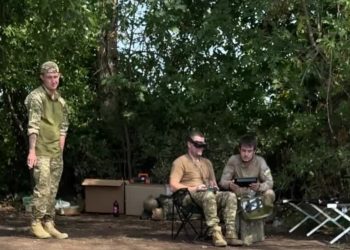“The general public was admitted to new Los Angeles County Museum of Art for the first time on Friday night — not to look at art but to listen to music,” wrote Times music critic Albert Goldberg in 1965. Exactly 70 years and three months later, history repeated itself.
Thursday night was the first time the public was allowed into LACMA’s David Geffen Galleries. The occasion was a massive sonic event led by jazz saxophonist Kamasi Washington. More than a hundred musicians spread out in nine groups along 900-foot serpentine route of Peter Zumthor’s new building, still empty of art.
The celebration, which drew arts and civic leaders for the first of three preview nights, was far grander than the concert on March 26,1965, that opened LACMA’s Leo S. Bing Theatre the night before the doors opened to the museum’s original galleries. That occasion, a program by the legendary Monday Evening Concerts in which Pierre Boulez conducted the premiere of his “Éclat,” helped symbolize an exuberant L.A. coming of age, with the Music Center having opened three months earlier.
Monday Evening Concerts had been a true L.A. event drawing local musical celebrities including Igor Stravinsky and showing off L.A.’s exceptional musicians. The mandolinist in “Éclat,” for instance, was Sol Babitz, the father of the late, quintessential L.A. writer Eve Babitz. Boulez, an explosive composer, eventually turned the 10-minute “‘Éclat,’ for 15 instruments” into a 25-minute orchestral masterpiece, “Éclat/Multiples,” and left unfinished sketches behind to extend that to a full hour.
Washington turned out to be the ideal radical expansionist to follow in Boulez’s footsteps for the new LACMA, with a resplendent enlargement of his 2018 half-hour EP, “Harmony of Difference.” The short tracks — “Desire,” “Knowledge,” “Perspective,” “Humility,” “Integrity” and “Truth” — employ nearly three dozen musicians in bursts of effusive wonder.
For LACMA, Washington tripled the number of musicians and the length. What some critics thought were bursts of bluster, however enthralling, became outright splendor. Introducing the program, LACMA Director Michael Govan called it an event that has never happened before and may never happen again. I got little sense of what this building will be like as a museum with art on the walls, but it’s a great space for thinking big musically and, in the process, for finding hope in an L.A. this year beset by fires and fear-inducing troops on our streets.
Washington is one of our rare musicians who thrives on excess. He has long been encouraged to aim toward concision, especially in his longer numbers, in which his untiring improvisations can become exhausting in their many climaxes. But that misses the point. I’ve never heard him play anything, short or long, that couldn’t have been three times longer. His vision is vast, and he needs space.
In the David Geffen Galleries, he got it. The nine ensembles included a large mixed band that he headed, along with ensembles of strings, brass, woodwinds and choruses. Each played unique arrangements of the songs, not quite synchronized, but if you ambled the long walkways, you heard the material in different contexts as though this were sonic surrealism.
Acoustically, the Geffen is a weird combination. The large glass windows and angled concrete walls reflect sound in very different ways. Dozens of spaces vary in shape, size and acoustical properties. During a media tour earlier in the day, I found less echo than might be expected, though each space had its own peculiarities.
Washington’s ensembles were all carefully amplified and sounded surprisingly liquid, which made walking a delight as the sounds of different ensembles came in and out of focus. A chorus’ effusiveness gradually morphed into an ecstatic Washington saxophone solo down the way that then became a woodwind choir that had an organ-like quality. The whole building felt alive.
There was also the visual element. The concert took place at sunset, the light through the large windows ever changing, the “Harmony of Difference” becoming the differences of the bubbling tar pits nearby or the street life on Wilshire or LACMA’s Pavilion for Japanese Art, which looks lovely from the new galleries.
Govan’s vision is of a place where art of all kinds from all over comes together, turning the galleries into a promenade of discovery.
Musically, this falls more in line with John Cage’s “Musicircus,” in which any number of musical ensembles perform at chance-derived times as a carnival of musical difference — something for which the Geffen Galleries is all but tailor-made. Nevertheless, Washington brilliantly demonstrated the new building’s potential for dance, opera, even theater.
The museum may not have made performance a priority in recent years, but Washington also reminded us that the premiere of Boulez’ “Éclat” put music in LACMA’s DNA. Seven decades on, Zumthor, whether he intended it or not, now challenges LACMA to become LACMAP: Los Angeles County Museum of Art and Performance.
The post How Kamasi Washington and 100 musicians filled LACMA’s empty new building with a sonic work of art appeared first on Los Angeles Times.




